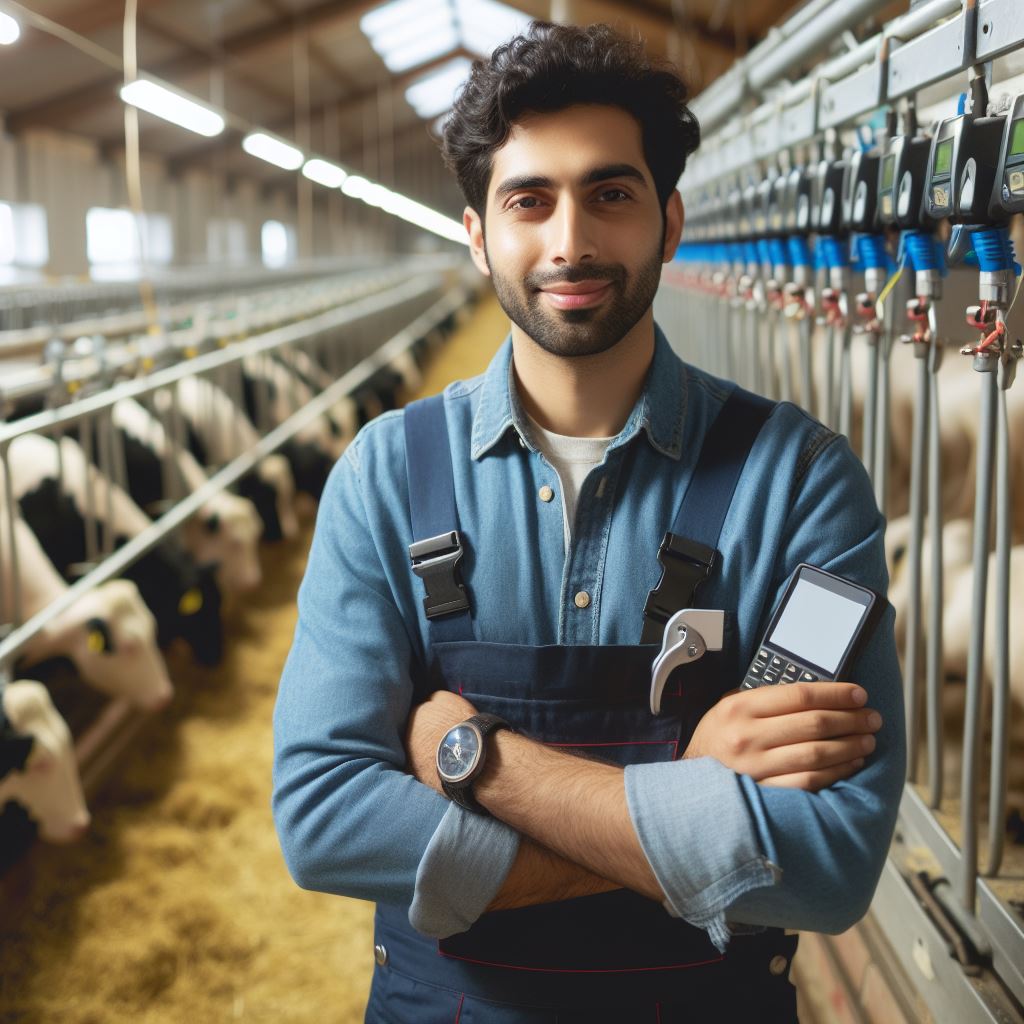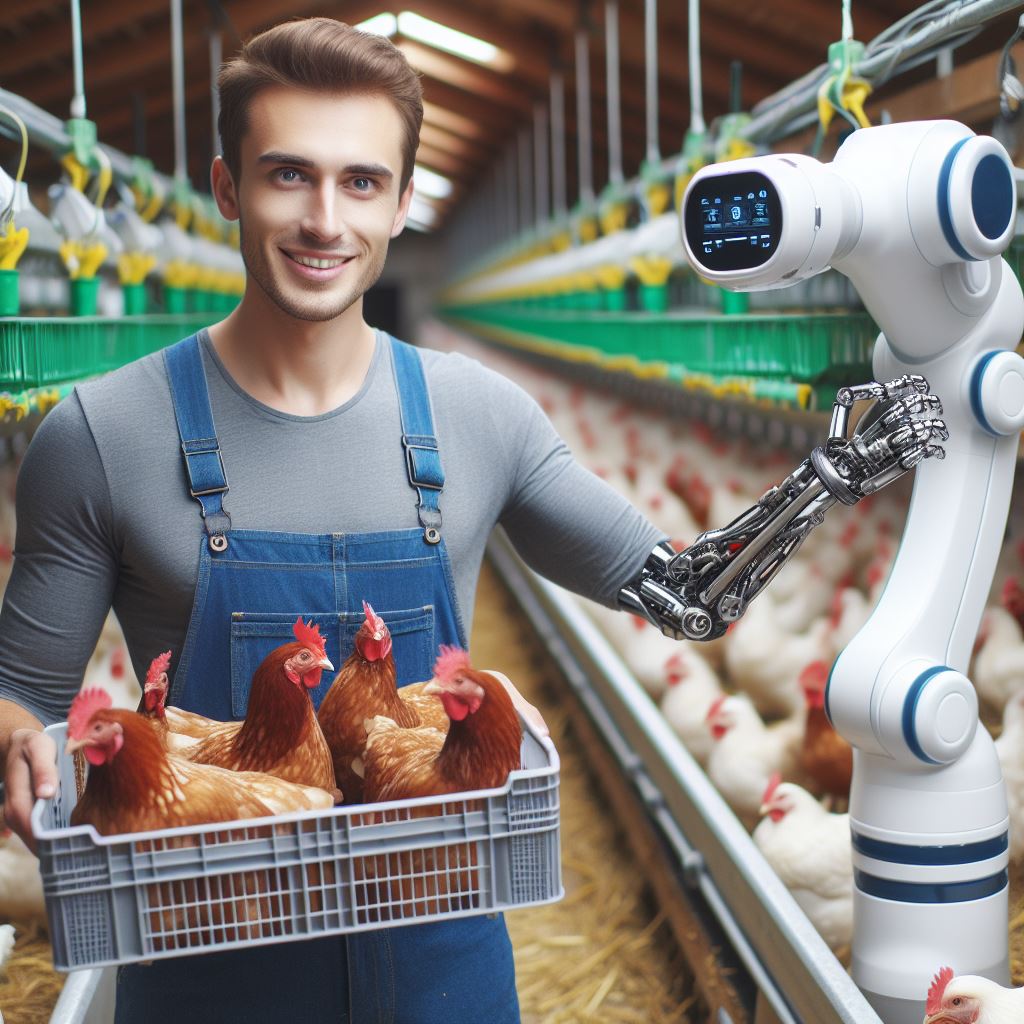Introduction
Let’s explore Temperature Control Tech in Livestock Sheds.
Introducing cutting-edge temperature control technologies in livestock sheds revolutionizes animal husbandry practices.
This marks a pivotal shift by:
- Enhancing Animal Welfare: Improving conditions for livestock, ensuring optimal comfort, and reducing stress-related issues.
- Precision Environmental Control: Utilizing advanced systems to regulate temperature, humidity, and ventilation, providing a customized environment for animals.
- Energy-Efficient Solutions: Incorporating eco-friendly technologies that optimize energy consumption while maintaining optimal conditions for livestock.
- Technological Integration: Seamlessly integrating sensors, automation, and monitoring systems to create a sophisticated and responsive livestock environment.
- Improved Productivity: Creating an environment conducive to animal well-being results in healthier livestock and, subsequently, enhanced productivity.
As we explore these temperature control innovations, it becomes evident how they redefine the landscape of modern livestock management.
Benefits of Temperature Control Technology
Improved animal welfare
Temperature control technology has revolutionized the way livestock sheds are managed, providing numerous benefits to both the animals and the farmers.
By implementing advanced temperature control systems, livestock farmers can optimize animal welfare, increase productivity, and achieve cost savings.
Improved animal welfare is one of the primary advantages of temperature control technology.
Livestock requires specific temperature ranges to flourish, and temperature control systems ensure these optimal conditions.
Whether it is cows, pigs, or chickens, each species has its ideal temperature range for comfort and productivity.
By maintaining these temperature ranges, farmers can improve animal welfare and maximize their well-being.
Increased productivity
Additionally, temperature control technology plays a crucial role in reducing stress levels in animals.
Animals, like humans, experience stress when exposed to extreme temperature conditions.
With temperature control systems in place, farmers can create a comfortable environment, minimizing stress levels and promoting better health among their livestock.
Reduced stress not only enhances the overall well-being of the animals but also improves their growth and productivity.
Temperature control technology also significantly increases productivity in livestock sheds.
Transform Your Agribusiness
Unlock your farm's potential with expert advice tailored to your needs. Get actionable steps that drive real results.
Get StartedBy maintaining suitable temperature conditions, farmers create an optimal environment for growth and production.
Livestock raised in controlled temperature settings experience fewer setbacks and can reach their maximum potential.
This has a direct impact on the farmer’s yield and profitability.
Cost savings
Furthermore, temperature control technology enhances feed conversion efficiency.
It ensures that the animals’ nutritional needs are met, allowing them to make the most out of their feed.
With this technology, livestock can convert feed into muscle or milk more efficiently, resulting in higher output.
Improved feed conversion efficiency not only benefits the farmers but also contributes to sustainable farming practices.
Cost savings are another advantage of temperature control technology.
Energy-efficient systems help reduce electricity consumption in livestock sheds, leading to significant cost savings.
With the ability to regulate temperature accurately, these systems can operate efficiently, minimizing energy waste.
Additionally, temperature control technology reduces feed and medication waste.
By maintaining optimal conditions, animals are less likely to become sick or require excessive medication.
This not only saves money spent on medication but also reduces the amount of feed wasted due to illness.
Generally, temperature control technology brings numerous benefits to livestock sheds.
From improved animal welfare and increased productivity to cost savings, this technology has revolutionized the livestock industry.
By investing in temperature control systems, farmers can create optimal conditions for their livestock, leading to healthier animals and higher yields.
Additionally, the cost savings achieved through energy efficiency and reduced waste make temperature control technology a wise investment for any livestock farmer.
Read: Pig Farm Biosecurity Essentials
Types of temperature control technology
Temperature control technology is crucial when it comes to creating the optimal environment for livestock sheds.
Livestock, such as poultry or swine, are particularly sensitive to temperature changes.
Extreme heat or cold can lead to stress, decreased productivity, and even mortality.
To ensure the well-being and productivity of livestock, various temperature control technologies are employed in livestock sheds.
This section will explore the different types of temperature control technology commonly used.
Heating systems
Heating systems are essential for maintaining a warm and comfortable environment during cold weather.
Showcase Your Farming Business
Publish your professional farming services profile on our blog for a one-time fee of $200 and reach a dedicated audience of farmers and agribusiness owners.
Publish Your ProfileTwo common types of heating systems used in livestock sheds are radiant heaters and forced-air heaters.
Radiant heaters emit infrared radiation that warms objects and animals directly, while forced-air heaters distribute heated air throughout the shed.
Cooling systems
During hot weather, cooling systems are necessary to prevent livestock from experiencing heat stress.
Evaporative cooling pads are widely used in livestock sheds.
These pads are placed in the air inlet openings and are kept wet.
As air passes through the pads, it is cooled before reaching the animals.
High-pressure misting systems are another effective cooling method.
They release a fine mist of water into the air, which evaporates and cools the surrounding environment.
Ventilation systems
Proper ventilation is crucial to maintain fresh air and control humidity levels in livestock sheds.
Natural ventilation is achieved through the strategic placement of openings, such as windows or vents, to allow for the flow of fresh air.
Mechanical ventilation, on the other hand, involves the use of fans or blowers to circulate air effectively.
This helps to remove stale air, control temperature, and reduce moisture levels.
Each type of temperature control technology has its advantages and considerations.
Factors such as climate, animal type, and shed size should be taken into account when choosing the appropriate system.
Additionally, it’s important to regularly maintain and monitor these systems to ensure optimal functionality.
In general, temperature control technology plays a crucial role in creating a comfortable and healthy environment for livestock in sheds.
Heating systems, cooling systems, and ventilation systems all contribute to maintaining an ideal temperature range, preventing stress and promoting productivity.
By implementing the right temperature control technology, livestock farmers can provide their animals with the optimal conditions for growth and well-being.
Read: Pig Behavior: Understanding Your Herd

Factors to Consider When Choosing Temperature Control Technology
Climate and Geographical Location
The climate and geographical location of the livestock shed play a crucial role in determining the suitable temperature control technology.
Different regions have varying temperature ranges, humidity levels, and weather patterns that need to be taken into account.
- Temperature Range: Consider the extreme temperatures experienced in the region throughout the year. Some areas have scorching summers and freezing winters, which require more robust temperature control systems.
- Humidity Levels: Humidity affects the comfort and health of livestock. High humidity can lead to heat stress and the growth of disease-causing organisms. The temperature control technology should be able to regulate both temperature and humidity effectively.
- Weather Patterns: Assess the weather patterns in the region. Does it frequently experience storms, heavy rains, or strong winds? This information is necessary to select temperature control technology that can withstand such conditions.
Livestock Type and Density
The type of livestock being raised and the density in the shed also impact the choice of temperature control technology.
Different species have specific temperature requirements, and overcrowding can affect the efficiency of the technology.
- Species-Specific Needs: Some livestock species are more susceptible to heat stress or require specific temperature ranges for optimal growth and productivity. Consider the specific needs of the livestock being raised in the shed.
- Adequate Ventilation: High-density livestock sheds can generate a significant amount of heat and moisture. Proper ventilation is crucial to maintain air quality, prevent humidity buildup, and control temperature effectively.
Shed Design and Layout
The design and layout of the livestock shed influence the effectiveness of temperature control technology.
The available space, orientation, and insulation level of the shed should be considered.
- Size and Layout: The size and layout of the shed determine the distribution and positioning of the temperature control systems. Whether it is a small or large shed, the technology should be able to cover the entire area adequately.
- Insulation: Proper insulation reduces heat transfer, prevents drafts, and helps maintain a more stable temperature within the shed. The chosen temperature control technology should complement the insulation system of the shed.
Budget and Cost-Effectiveness
Budgetary constraints are an important factor when selecting temperature control technology.
The initial investment, operational costs, and long-term benefits should be carefully evaluated.
- Initial Investment: Consider the upfront investment required for the installation of the temperature control technology. Compare the different options available, their prices, and their compatibility with the shed.
- Operational Costs: Assess the recurring costs associated with the chosen technology, including energy consumption, maintenance, and repairs. Opt for energy-efficient solutions to minimize operational expenses.
- Long-term Benefits: Look beyond the immediate costs and evaluate the long-term benefits each temperature control technology offers. Consider factors such as durability, reliability, and potential for energy savings.
Ease of Maintenance and Operation
The ease of maintenance and operation is crucial to ensure the efficient and sustainable functioning of temperature control technology.
- Maintenance Requirements: Some temperature control systems may require regular cleaning, filter changes, or sensor calibrations. Choose technology that aligns with the available maintenance resources and expertise.
- User-Friendly Interface: Consider the ease of operation of the temperature control technology. Ideally, it should have a user-friendly interface and intuitive controls that can be easily understood and adjusted by staff.
Lastly, several factors need to be considered when choosing temperature control technology for livestock sheds.
Climate, geographical location, livestock type and density, shed design, budget, and maintenance requirements all play a significant role in determining the most suitable solution.
By carefully evaluating these factors, livestock farmers can ensure a comfortable and optimal environment for their animals, leading to better productivity and animal welfare.
Read: Layer vs. Broiler: Choosing Your Poultry Path
Delve into the Subject: Rabbit Feed Types: Balancing Nutrition & Growth
Case studies and success stories
Example 1: Implementation of temperature control technology in a dairy farm
One dairy farm decided to adopt temperature control technology to enhance the environment for their cows.
Before the implementation, temperature fluctuations affected cow comfort and milk production.
However, after installing the temperature control system, significant improvements were observed.
Before and after comparisons were conducted to evaluate the impact of the technology.
The data showed that cows’ comfort levels increased substantially, resulting in enhanced overall welfare.
The cows appeared less stressed, which positively influenced their milk production.
Moreover, milk production witnessed a remarkable increase.
Showcase Your Farming Business
Publish your professional farming services profile on our blog for a one-time fee of $200 and reach a dedicated audience of farmers and agribusiness owners.
Publish Your ProfileThe optimal temperature provided by the control system created a comfortable and conducive environment for the cows, allowing them to produce more milk.
Farmers also noticed improved milk quality, contributing to greater profitability.
Example 2: Poultry farm temperature management system
In another case, a poultry farm implemented a temperature management system to address challenges related to temperature fluctuations and disease outbreaks among the birds.
The technology proved to be transformative for their operations.
After integrating the temperature control system, the farm experienced a range of benefits.
Firstly, the improved environmental conditions positively impacted feed conversion and growth rate among the poultry population.
This led to reduced feed costs and more efficient production, increasing overall profitability.
Additionally, the temperature management system played a crucial role in mitigating disease outbreaks.
Poultry farms are prone to diseases, particularly when temperature fluctuations occur.
However, with the implementation of the technology, the farm noticed a significant decline in disease incidents.
This not only safeguarded the birds’ health but also reduced treatment costs and losses associated with diseases.
The success stories of these two livestock farms demonstrate the impact of temperature control technology.
By creating favorable and stable conditions, farmers can significantly enhance productivity, animal welfare, and profitability.
The implementation of such systems proves to be a wise investment in the long run, securing the future of livestock farming.
Implementing temperature control technology in livestock sheds can yield significant benefits for both animals and farmers.
This section explores two case studies and success stories that highlight the positive outcomes of using such technology.
Read: Poultry Management: Key Techniques
Challenges and considerations
Initial investment costs
Implementing temperature control technology in livestock sheds can come with significant initial costs.
However, these costs are necessary to ensure the comfort and well-being of the animals.
Investments are required for purchasing and installing climate control systems, such as cooling fans and heating units.
There may also be expenses associated with the necessary infrastructure, such as electrical wiring and ventilation systems.
Nevertheless, the long-term benefits and improved productivity often outweigh the upfront expenses.
Regular maintenance and troubleshooting
Once the temperature control systems are in place, regular maintenance and troubleshooting become essential.
Regular inspections and servicing are needed to ensure all components are functioning optimally and to prevent system failures.
Issues such as sensor inaccuracies, fan malfunctions, or thermostat failures may arise and need prompt attention.
Having trained staff who can handle maintenance and troubleshooting effectively is crucial to avoid any adverse impact on the livestock.
Regular maintenance and prompt troubleshooting can help prevent costly repairs and ensure uninterrupted temperature control.
Potential risks and technical failures
Despite implementing temperature control technology, there are potential risks and unforeseen technical failures that may occur.
Power outages or fluctuations can temporarily disrupt the functioning of the cooling or heating systems.
Inadequate insulation or issues in the shed’s construction may lead to temperature imbalances that affect the livestock.
System malfunctions can result in sudden temperature changes or failures to maintain the desired climatic conditions.
To mitigate these risks, it is essential to have backup systems, alarms, and regular system checks to identify any potential failures.
Upgrading existing systems
Another consideration is upgrading existing temperature control systems to keep up with technological advancements.
Newer systems may offer improved efficiency, better temperature accuracy, and additional features for enhanced animal welfare.
While this involves additional investment, the potential benefits in terms of animal health and productivity are worth considering.
Regular evaluation of existing systems and staying updated with the latest technologies is crucial to ensure optimal temperature control.
Environmental sustainability
The environmental sustainability of temperature control technology in livestock sheds is a significant consideration.
Energy consumption should be monitored to minimize the carbon footprint associated with cooling or heating operations.
Using renewable energy sources, such as solar power, can help reduce the reliance on non-renewable resources.
Efficient insulation and air circulation systems can also contribute to minimizing energy wastage and reducing environmental impact.
Showcase Your Farming Business
Publish your professional farming services profile on our blog for a one-time fee of $200 and reach a dedicated audience of farmers and agribusiness owners.
Publish Your ProfileStriking a balance between optimum temperature control for livestock and sustainable practices is essential for responsible farming.
Implementing temperature control technology in livestock sheds can offer numerous benefits, but it also presents challenges and considerations.
Initial investment costs, regular maintenance, and troubleshooting are key factors that require attention.
Potential risks and technical failures need to be addressed through proper backup systems and regular checks.
Upgrading existing systems and focusing on environmental sustainability further contribute to a successful deployment of temperature control technology in livestock sheds.
By overcoming these challenges and considering the necessary factors, farmers can enhance animal welfare, productivity, and overall operational efficiency.
Conclusion
Recap of the importance of temperature control in livestock sheds
Temperature control is crucial in livestock sheds to ensure optimal animal health and productivity.
Benefits and considerations of temperature control technology
Implementing temperature control technology in livestock sheds provides numerous benefits, including improved growth rates and reduced mortality.
However, farmers should carefully consider factors such as initial investment costs and ongoing maintenance requirements.
Encouragement for farmers to explore and invest in suitable systems
Despite the challenges, it is essential for farmers to explore and invest in appropriate temperature control systems for their livestock.
Doing so will enhance animal welfare, increase profitability, and ensure long-term sustainability of their farming operations.
By prioritizing temperature control, farmers can create optimal living conditions for their livestock, allowing them to thrive and reach their full potential.




